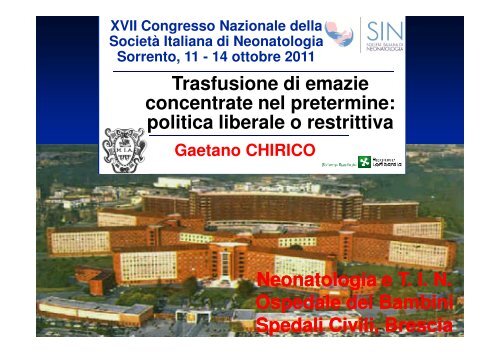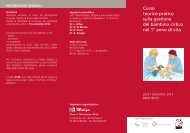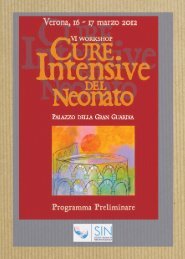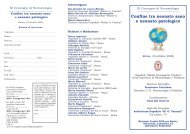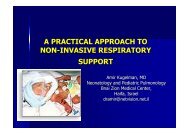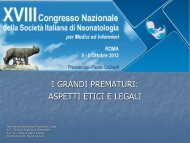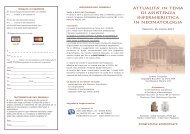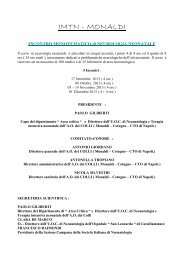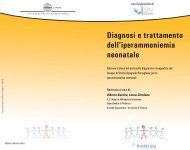Iowa and PINT trial - SIN :: Congresso 2011 - Società Italiana di ...
Iowa and PINT trial - SIN :: Congresso 2011 - Società Italiana di ...
Iowa and PINT trial - SIN :: Congresso 2011 - Società Italiana di ...
Create successful ePaper yourself
Turn your PDF publications into a flip-book with our unique Google optimized e-Paper software.
The CBC: Reference Ranges forNeonates (Christensen, 2009)
Transfusion guidelines for neonates <strong>and</strong>older childrenBritish Journal of Haematology, 2004; 124, 433–453453Suggested red blood cells transfusion thresholds for infantsunder 4 months of age• Anaemia in the first 24 hHb 12 g/dl (Hctc. 0.36)• Cumulative blood loss in 1 week,neonate requiring intensive care 10% blood volume• Neonate receiving intensive care• Acute blood loss 10%• Chronic oxygen dependency• Late anaemia, stable patientHb 12 g/dlHb 11 g/dlHb 7 g/d
Gruppo <strong>di</strong> Stu<strong>di</strong>o SIMTI-<strong>SIN</strong>: <strong>SIN</strong>:Recommendations on transfusiontherapy in Neonatology.Blood Transfus 2006; 4: 158-8080• VLBW Neonates undergoing mechanical ventilation or FiO2> 0.4 with Hct
Markers of transfusion needs in neonates• Anemia: haemoblobin (Hb)/haematocrit(Ht) values in relation to thereference ranges of Hb or Ht at <strong>di</strong>fferent post natal ages.• Clinical status of the newborn, particularly in presence of severecar<strong>di</strong>o-pulmonary <strong>di</strong>seases, or of symptoms of anemia suggestinginadequate tissue oxygenation, such as increase in oxygenrequirement, tachycar<strong>di</strong>a, apnea, poor weight gain.• Reticulocyte counts < 100000/µL.• High blood lactate levels.• Hemodynamic changes detected by echocar<strong>di</strong>ography.• Peripheral fractional oxygen extraction, or Splanchnic-cerebral cerebraloxygenation ratio measured by near infrared spectroscopy.• Spectroscopic Noninvasive Measurement of Hemoglobin.• Regional cerebral oximetry.• High concentrations of Vascular Endotelial Growth Factor as in<strong>di</strong>catorof insufficient oxygen delivery to tissues.
- Blood transfusions increase cerebral, splanchnic, <strong>and</strong> renaloxygenation in anemic preterm infants (Dani, 2010).- Splanchnic-cerebral cerebral oxygenation ratio as a marker ofpreterm infant blood transfusion needs (Bailey, <strong>2011</strong>).SCOR = splanchnic-cerebralcerebral oxygenation ratio determined using near-infraredspectroscopy (NIRS).
• “Critical Hb levels for maintaining adequate oxygentransport are <strong>di</strong>fficult to define, <strong>and</strong> provide an imprecisemeasure of tissue oxygen delivery.”• “The physiological impact of anemia in the neonate isaltered by so many variables that it is <strong>di</strong>fficult to findsimple clinical or laboratory in<strong>di</strong>cators to determine whenintervention is required.” (Ramasethu, 1999)Factors that influence the oxygentransport system:regulation of the stroke volume,degree of affinity of the Hb for oxygen,concentration of Hb,arterial oxygen tension,oxygen extraction fraction,consumption of oxygen.
Neonatal red blood cell transfusions: searching forbetter guidelines (Kasat, <strong>2011</strong>)Reasons for transfusion: guidelines; care-givers'perceptions of need for packed RBC transfusion; or both.
“<strong>Iowa</strong> <strong>trial</strong>”“<strong>PINT</strong> <strong>trial</strong>”
Comparison of characteristics of<strong>Iowa</strong> <strong>and</strong> Premature Infants in Needof Transfusion <strong>trial</strong>sIOWASingle center(restr. vs liberal)<strong>PINT</strong>Multicenter100 pts 500–1300 g 451 pts
“<strong>Iowa</strong> <strong>trial</strong>”LIBERAL RESTRICTIVEAssisted Ventilation
Comparison of characteristics of <strong>Iowa</strong> <strong>and</strong>Premature Infants in Need of Transfusion <strong>trial</strong>s(restr. vs liberal)IOWA<strong>PINT</strong>Highest Hb threshold 11.3 - 15.3 11.5 - 13.5Lowest Hb threshold 7.3 - 10 7.5 - 8.5Mean Hb 8.3 - 11.0 10.1 - 11.2Mean Hb <strong>di</strong>ff. 2.7 1.1<strong>PINT</strong> <strong>trial</strong>
<strong>Iowa</strong> <strong>and</strong> <strong>PINT</strong> <strong>trial</strong>: Short-termterm outcome<strong>Iowa</strong> TRIAL• Pretransfusion hematocrit, arterial oxygen content, <strong>and</strong> systemicoxygen transport values were significantly higher in the liberal-transfusion group, while plasma erythropoietin concentration washigher in the restrictive transfusion group.• Infants in the liberal-transfusion group received more RBCtransfusions (mean 5.2) as compared to the restrictive-transfusion transfusiongroup (mean 3.3).• Infants in the restrictive-transfusion transfusion group showed a trend (notstatistically significant) for increased intraparenchymal brainhemorrhage or periventricular leukomalacia, <strong>and</strong> they had morefrequent episodes of apnea.<strong>PINT</strong> <strong>trial</strong>• No <strong>di</strong>fference in death or major morbi<strong>di</strong>ty with restrictive or liberaltransfusion regimens. By <strong>di</strong>scharge from the hospital, fewer infants(89%) in the low threshold group had received a transfusion, comparedwith the high threshold group (95%).• Conclusions were that in extremely low birth weight infants,maintaining a higher haemoglobin level resulted in more infantsreceiving transfusions without evidence of benefit.
<strong>Iowa</strong> <strong>and</strong> <strong>PINT</strong> <strong>trial</strong>: Long-termoutcome<strong>Iowa</strong> TRIAL, 12 years follow-up• MR showed that intracranial volume was substantially smaller in theliberal group compared with controls. Cerebral white matter wasreduced in both preterm groups, more so for the liberal group. Whensex effects were evaluated, the girls in the liberal group had the mostsignificant abnormalities. These data suggested that red blood celltransfusions affected the long-term outcome of premature infants asin<strong>di</strong>cated by reduced brain volumes at 12 years of age for neonateswho received transfusions using liberal guidelines.<strong>PINT</strong> TRIAL, 18 to 21 months’ corrected age follow-up• The primary composite outcome was death or the presence of cerebralpalsy, cognitive delay, or severe visual or hearing impairment. Therewas no statistically significant <strong>di</strong>fference in the primary outcome,found in 45% in the restrictive group <strong>and</strong> 38% in the liberal group.• At 18 months measures of length, weight, <strong>and</strong> head circumferencewere strikingly similar. However, the <strong>di</strong>fference in cognitive delay(Mental Development Index score < 70) approached statisticalsignificance. A posthoc analysis with cognitive delay redefined (MentalDevelopment Index score < 85) showed a significant <strong>di</strong>fferencefavouring the liberal threshold group.
Long-term Outcome of Brain Structurein Premature Infants. Effects of Liberal vs RestrictedRed Blood Cell Transfusions (Nopoulos, <strong>2011</strong>)
Comparison of characteristics of <strong>Iowa</strong> <strong>and</strong>Premature Infants in Need of Transfusion <strong>trial</strong>s(restr. vs liberal)IOWA<strong>PINT</strong>Mean BW 954 – 958 g 771 – 769 gMean GA 28 – 28 wks 26 – 26 wksHighest Hb threshold* 11.3 - 15.3 11.5 - 13.5Lowest Hb threshold* 7.3 - 10 7.5 - 8.5Mean Hb 8.3 - 11.0 10.1 - 11.2Mean Hb <strong>di</strong>ff. 2.7 1.1*<strong>Iowa</strong>: Assisted Ventilation, CPAP/O2, None<strong>PINT</strong>: Respiratory Support, Age 1-7, 7-14, >14 days
36 VLBW preterm babies were r<strong>and</strong>omized to restrictive or liberal criteriafor packed red blood cell transfusion.Infants in the liberal group received a larger packed red blood celltransfusion volume compared with the restrictive group over 30 days(41.7 ± 20.1 vs. 27.2 ± 15.9 mL).There were no significant <strong>di</strong>fferences in the proportion of patients withrespiratory <strong>di</strong>stress syndrome, patent ductus arteriosus, severeintraventricular hemorrhage, ROP or CLD between the two groups.However, a total transfused blood volume greater than 30 mL over 30days was a risk factor for developing CLD in VLBW infants.The authors suggested that restrictive criteria for minimizing the overallamount of transfusion to less than 30 mL may be a better way ofpreventing CLD in VLBW infants.
Observational follow-up study on long-term outcome at 24months corrected age in relationship to neonatal transfusionvolume.Extremely premature born infants treated in 2 neonatalintensive care units using a <strong>di</strong>fferent transfusion volume (15ml/kg in Unit A <strong>and</strong> 20 ml/kg in Unit B).No relationship was found between the composite outcome<strong>and</strong> transfusion volume received during the post natalhospital stay.The conclusions were that as there was no clinical advantageof the higher transfusion volume, a more restrictive volumewill reduce total transfusion volume <strong>and</strong> donor exposure.
Effects of Transfusions in Extremely Low Birth WeightInfants: A Retrospective Study (Valieva, 2009)2006 guidelines, adapted from Shannon1. HCT 35% inspired O2 on CPAP, or positive pressureventilation with mean airway pressure >6 cmH2O2. HCT
Anaemia of prematurity:Pathophysiology <strong>and</strong> treatment(Strauss, 2010)Allogeneic RBC transfusions for the anaemia of prematurity.Transfuse to maintain the blood HCT per each clinicalsituation:• >40% (35 to 45%*) for severe car<strong>di</strong>opulmonary <strong>di</strong>sease• >30% for moderate car<strong>di</strong>opulmonary <strong>di</strong>sease• >30% for major surgery• >25% (20 to 25%*) for symptomatic anemia• >20% for asymptomatic anemia*Reflects practices that vary among neonatologists. Thus,any value within range is acceptable for local practices
Gruppo <strong>di</strong> Stu<strong>di</strong>o SIMTI-<strong>SIN</strong>: <strong>SIN</strong>:Recommendations on transfusiontherapy in Neonatology.Blood Transfus 2006; 4: 158-8080• Neonates undergoing mechanical ventilation or FiO2 > 0.4with Hct
Laboratory Blood Loss: The 1ºMechanism Lea<strong>di</strong>ng to Neonatal Anemia(Widness, 2006)1 mL of blood from a1 kg infant …… is equivalent to 70mL from a 70 kg Adult!
Early erythropoietin for preventing red bloodcell transfusion in preterm <strong>and</strong>/or low birthweight infants (OhlssonA, Aher SM, 2010)Authors’ conclusionsEarly administration of EPO reduces the use of RBC transfusions <strong>and</strong>the volume of RBCs transfused. These small reductions are of limitedclinical importance.Donor exposure is probably not avoided since most stu<strong>di</strong>es include<strong>di</strong>nfants who had received RBC transfusions prior to <strong>trial</strong> entry.There was a significant increase in the rate of ROP (stage > 3).Early EPO does not significantly decrease or increase any of the otherimportant adverse outcomes.Ongoing research should deal with the issue of ROP <strong>and</strong> evaluate thecurrent clinical practice that will limit donor exposure.Due to the limited benefits <strong>and</strong> the increased risk of ROP, earlyadministration of EPO is not recommended.Evidence is lacking for the possible neuroprotective role of EPO inpreterm infants.
Late erythropoietin for preventing red bloodcell transfusion in preterm <strong>and</strong>/or low birthweight infants (AherSM, Ohlsson A, 2010)Authors’ conclusionsLate administration of EPO reduces the use of one or more RBCtransfusions, the number of RBC transfusions per infant <strong>and</strong> the totalvolume of RBC transfused per infant.Any donor exposure is likely not avoided as most stu<strong>di</strong>es include<strong>di</strong>nfants who had received RBC transfusions prior to <strong>trial</strong> entry.Late EPO does not significantly reduce or increase any clinicallyimportant adverse outcomes.Further research of the use of late EPO treatment to prevent donorexposure is not in<strong>di</strong>cated.30%Transfusions by Week (% Total)Research efforts should focus on1982 1989 1993limiting donor exposure during the first 20%few days of life in sick neonates, whenRBC requirements are most likely to be10%~50%required <strong>and</strong> cannot be prevented by~70%0%late EPO treatment.1 2 3 4 5 6 7 8 9 10 11 >10 12wkPostnatal Week of Life
Erythropoietin for neonatal brain injury:opportunity <strong>and</strong> challenge (Xiong, <strong>2011</strong>)Benefits of EPO•Anemia of preterminfant•Brain injury ofpreterm infant•Hypoxic-ischemicencephalopathyRisks of EPO•Retinopathy ofprematurity•Hypertension•Coagulation•Haemangioma•Interfering neuronaldevelopment
Changes in Neonatal Transfusion Practice AfterDissemination of Neonatal Recommendations (Motta et al,Pe<strong>di</strong>atrics 2010)Implementing a program to improve compliance withneonatal intensive care unit transfusion guidelines wasaccompanied by a reduction in transfusion rate: a pre-post postanalysis within a multihospital health care system (Baeret al,Transfusion, <strong>2011</strong>)
StudyDelay in Cord Clamping >30 sec (Rabe, Cochrane, 2004)Any Transfusion in Premature InfantsEarlyn/NDelayedn/NRelative Risk (Fixed)95% CIWeight(%)Relative Risk(Fixed) 95%CIKinmond (1993) 7/13 1/13 7.0 7.00 [1.00, 49.16]McDonnell (1997)6/23 4/23 28.1 1.50 [0.49, 4.62]Rabe (2000) 16/20 9/19 64.9 1.69 [1.00, 2.85]Total N (95% CI) 56 55 100.0 2.01 [1.24, 3.27]Total events: 29 (Early), 14 (Delayed)Test for heterogeneity chi-square = 2.26,df = 2, p = 0.32Test for overall effect z = 2.81, p = 0.0050.01 0.1 I 10 100Favors Early Clamping Favors Delaying Clamping
Delayed Cord Clamping (DCC) in Very PretermInfants Reduces the Incidence of IntraventricularHemorrhage <strong>and</strong> Late-Onset Sepsis: A R<strong>and</strong>omized,Controlled Trial (Mercer, 2006)
Milking Compared With Delayed CordClamping to Increase Placental Transfusionin Preterm Neonates (Rabe, <strong>2011</strong>)
Hosono S, et al. Umbilical cord milking reduces the need for red celltransfusions <strong>and</strong> improves neonatal adaptation in infants born at lessthan 29 weeks' gestation: a r<strong>and</strong>omised controlled <strong>trial</strong>. Arch Dis ChildFetal Neonatal Ed. 2008;93:F14-9.Hosono S, et al. Blood pressure <strong>and</strong> urine output during the first 120 h oflife in infants born at less than 29 weeks' gestation related to umbilicalcord milking. Arch Dis Child Fetal Neonatal Ed. 2009;94:F328-31.%
CORRELATION BETWEEN CD34+ CELLS (HEMATOPOIETICPROGENITORS) AND GESTATIONAL AGE280240Number of CD34+ cells2001601208040016 20 24 28 32 36 40 44Gestational age, weeksGasparoni, Chirico et al, 2000


